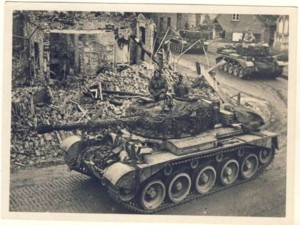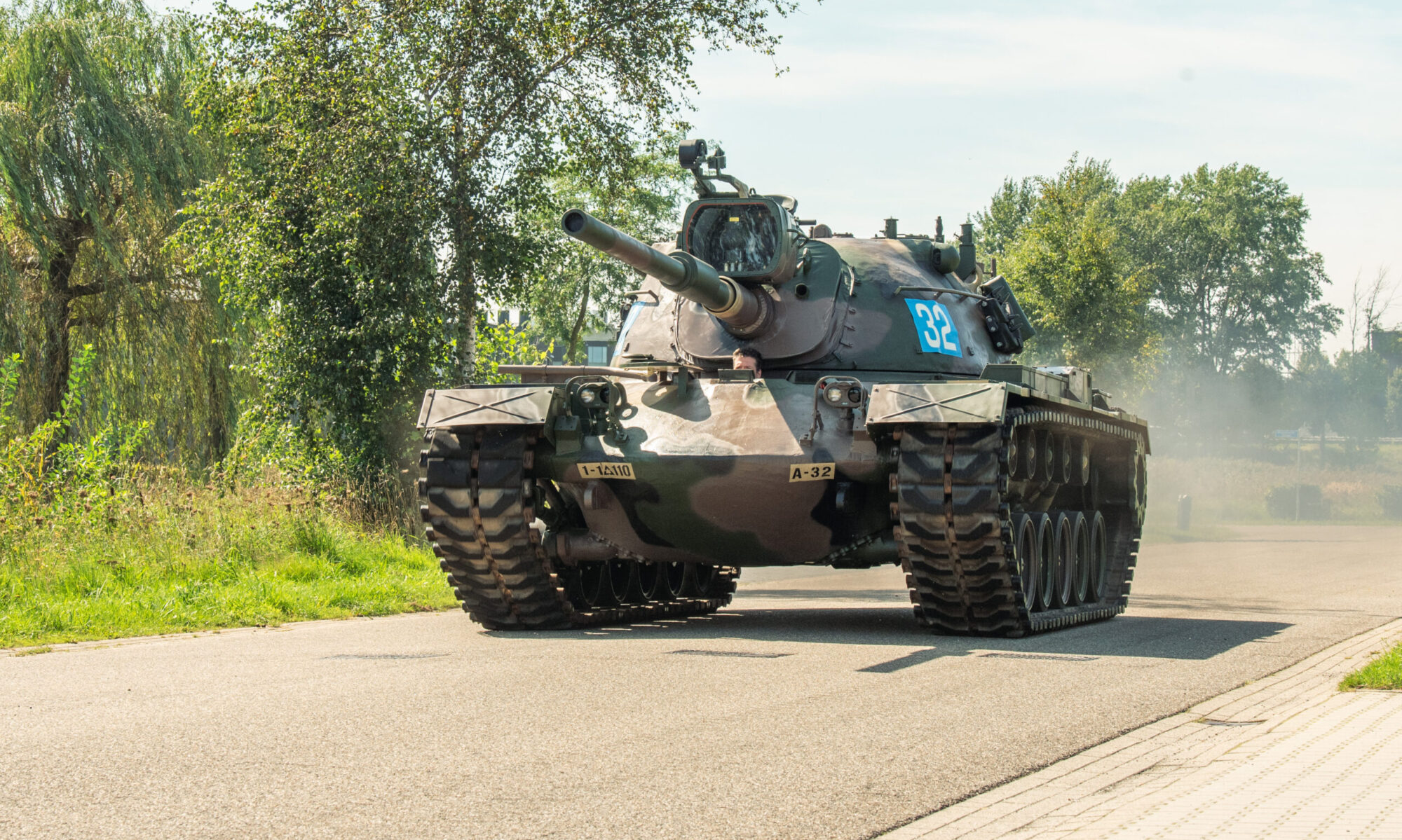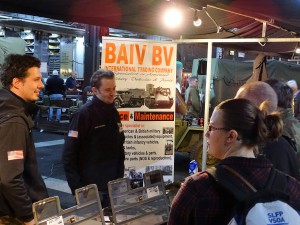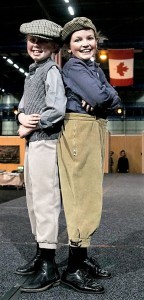BAIV has been awarded by one of our respected clients to execute a ground-up restoration on 2 British WW-II surviving and very unique Comet tanks.
Our client is a 44 year old gentleman who grew up in the midwest of America on a farm around tractors.
He was always interested in world history, combined with an appreciation of large mechanical implements.
Recently he stated in this respect a quote from Napoleon Bonaparte
“Between a battle lost and a battle won, the distance is immense and there stand empires”.
According our client a major factor of historical influence in determining the outcomes of battles is the balance of technology regarding weapons and Armour. According his opinion the evolution of tanks reflects this key factor in wars since the early twentieth century.
After he left the farm and going into business (Neurological Surgeon), he began collecting armoured vehicles over a decade ago.
The future owner of these incredible historic A34 Comets has a collection of about twenty tanks, extending from WW1 to the 21st Century.
British armour from WW-II will have become more and more popular. In this respect both Comet tanks are most desired as being the best tank built by the British in WW-II!
The Tank projects we currently have in our workshop are an A34 Comet Mk 1 Model A build by Leyland and hull number T335252 and a A34 Comet Mk1 Model B build by John Fowler & Co leeds under contract M10536 and hull number T335817.
See for more information both restoration pages: Comet T335252 & Comet T335817

For most of WW2, the British Army operated what were described as ‘cruiser’ and ‘infantry’ tanks. The designation ‘cruiser’ had been introduced in 1938 to describe what had previously been known as ‘medium’ tanks…… and, at the same time, the ‘infantry’ class was introduced to describe tanks that were used in support of infantry.
Logically enough, the first tank in each of these series was described as Mk I -as in ‘cruiser’ tank Mk I- but it wasn’t long before the ‘cruiser’ tank class included more designs than you could shake a stick at. There were the unnamed Mk I to IV, the Mk V Covenanter, Mk VI Crusader, Mk VII Cavalier, and then after the ‘Mark’ numbers were dropped, the Centaur, Cromwell, and Challenger were produced… and finally the ‘Comet’
During the days of WW2 they found out that they clearly a new tank wich can carry a gun of sufficient power to penetrate the German armour, and yet still offered the good speed and mobility.

Vickers-Armstrong produced an L/50 75mm gun which could fire a 15 lb armour-piercing projectile at a muzzle velocity of 2.650 ft./sec (780m/sec), and which was sufficiently compact to fit into a tank turret. This seemed to be a good bet for the up-gunned cruiser but, in the interests of standardisation, somebody at the Department of Tank Design suggested that life might be a lot simpler if the bore was increased to 3 inch (76.2mm), allowing the gun to fire the projectiles used by the 17-pounder towed anti-tank gun.
Good idea! but, the ’17-pounder cartridge case was too large. Vickers made changes to the breech to allow the use of shorter-cased ammunition which was devised especially for this purpose and the resulting weapon was designated ‘gun, OQF, tank, 77mm Mk I’- ’77 mm being included in the nomenclature to avoid confusion with the (long-cased) 76.2mm ammunition which remained in production for the original weapons.
In this revised form, the new 77mm gun was capable of firing the standard 17 lb armour-piercing shot at a muzzle velocity of 2.600 ft./sec. (792 m/sec) which was sufficient to penetrate 109 mm of armour at 500 yards (457m). In theory, this was indeed sufficient to defeat ‘any German tank’ providing the gunner could get close enough.
By 1945, armour-piercing discarding sabot (APDS) rounds were available giving a muzzle velocity of 3.600 ft./sec. (1.098 m/sec). It proved itself to be an extremely accurate weapon.
Sadly whilst the gun may have been successful it proved difficult to simply up-gun the the current Cromwell. So they designed a tank around the new gun. Work on what was to become the A34 Comet -the last in the production series of British cruiser tanks- began in July 1943. Leyland Motors had turned a whole factory over to tank production and were already engaged in producing Centaurs and Cromwell’s and this seemed the logical place for the Comet.
![real_british_riders_on_a_comet_in_early_1945._iwm.cbu3203_crop1[1]](http://www.baiv.nl/wp-content/uploads/2015/10/real_british_riders_on_a_comet_in_early_1945._iwm.cbu3203_crop11-300x199.jpg)
The design brief called for the tank to be armed with the new 77mm gun and to retain as many features of the Cromwell as possible in order to reduce development time. A mock-up was ready by September 1943 and the first prototype was ready for testing in February 1944.
Production had initially been scheduled for mid-1944 but there were initial problems with the suspension which required some modification, as well as other small changes.
In appearance, the Comet was very similar to the Cromwell although it could easily be recognised by its new, welded turret and by the longer-barrelled gun which, unlike the old 6-pounder, incorporated a muzzle brake to reduce recoil.
Power was provided by a Rover or Morris built Meteor Mk III engine, similar to that which had been used in the Cromwell; Power output was 600 bhp from 27,022cc and the engine drove the rear sprockets through a five-speed Merritt-Brown combined gearbox and steering unit. The Comet was considerably heavier than the Cromwell, with the combat weight up from 27 tons to around 33 tons, and this had the effect of reducing the top speed to 32 mph (52 km/h).
The weight increase also necessitated increasing the width of the tracks when compared to the Cromwell. Operating range was around 125 mites (202 km), during which time the tank would have consumed 116 gallons (527 litres) of fuel.
The Christie-type suspension which had been seen on all of the cruiser tanks was retained, albeit strengthened to support the greater weight. For the first time, at least on the series production models, there were track return rollers, bringing a big improvement in the ride.
The tank was designed to be operated by a five-man crew consisting of commander, driver, gunner loader and ‘bow gunner’, the latter operating the bow machine gun.
Manufacturing began in late 1944 at Leyland, and some 143 examples had been constructed by January 1945 when the tank entered service with the 29th Armoured Brigade, replacing the unit’s Sherman’s. The 15/19 Hussars were also issued with Comets and the tank saw its first action during ‘Operation Varsity’, the Rhine crossing in March of that year. There were just two variants, generally described as the Mk 1A and Mk 1B.
The Comet was without any doubt fast, reliable and well-armed, and was particularly agile across country -many saw it as the best British tank of WWII! Although it came relatively late to see more than a few months action in the battle for Europe, it remained in service with the British Army until 1958.















![real_british_riders_on_a_comet_in_early_1945._iwm.cbu3203_crop1[1]](http://www.baiv.nl/wp-content/uploads/2015/10/real_british_riders_on_a_comet_in_early_1945._iwm.cbu3203_crop11-300x199.jpg)
